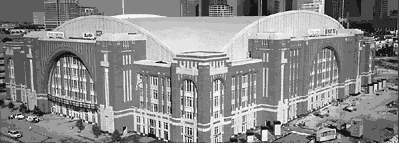 Instead of looking for land in the outer suburbs to house a new stadium for its basketball and hockey teams, the city of Dallas decided to assist developers in cleaning up a 72-acre toxic mess at the city’s core.
Instead of looking for land in the outer suburbs to house a new stadium for its basketball and hockey teams, the city of Dallas decided to assist developers in cleaning up a 72-acre toxic mess at the city’s core.
Where there once was arsenic and lead leftovers from a 100-year old city dump, the American Airlines center opened this summer, serving sushi and sea bass to its sports and entertainment fans. Where once motor oil and benzene spills leached into soil and groundwater from abandoned industrial and railroad facilities, 8 million sq. ft. of apartments, offices, stores and entertainment will meander around the arena, providing auto-weary Dallas commuters with a place to live, work and play downtown.
Mayor Ron Kirk recognized that building a $1 billion development would keep dollars and jobs from migrating to the suburbs. “The manufacturers and polluters abandoned this 30 years ago, but we’ve cleaned it up and put it back on the tax rolls.”
The $12 million clean up costs were a small fraction of total dollars spent, and were partially borne by previous land owners responsible for the pollutants. Developers had to haul away 15,000 huge truck loads of contaminated soil and clean 15 million gallons of polluted groundwater.
The nation’s largest brownfield project is Bethlehem Steel’s $1.5 billion plan to convert its Pennsylvania steel mill into an entertainment and retail complex. At its heart will be a Smithsonian-affiliated American Museum of Industrial History featuring blast furnaces, painted and preserved. Giant vats that formerly moved steel will become people-movers. The plant dates back to 1870. It covers four and a half miles of river frontage, and once employed 30,000. The proposed complex with its cinema, shops, ice rink, and hotel could have enormous economic and social implications for Bethlehem’s south side neighborhoods of Puerto Rican Americans, providing up to 10,000 jobs and a $70 million tax base.
Another brownfield in Chicago will become the site of a solar-generated energy plant that will sell energy to the city.
There is a realization that if you remove the dangerous elements, the land can be reused and recycled to benefit the surrounding community.
(Source: U.S. Environmental Protection Agency)



















